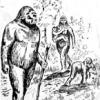The links below are blog articles by a scientist who was trying to calculate the expected number of bigfoot roadkill per year.
The first article estimated the BF roadkill probabilities using US statistics from car accidents with human pedestrians. However, because some issues with this data (for example, car pedestrian accident data is weighted towards urban areas) the author wrote the 2nd paper using larger mammal hit and kill rate statistics.
http://thoughtsonscienceandpseudoscience.blogspot.com/2012/11/does-bigfoot-exist-statistical-evidence.html
http://thoughtsonscienceandpseudoscience.blogspot.com/2012/12/an-updated-analysis-of-animal-roadkill.html
Both papers are interesting and worth the read. I also suggest to read the comment section that points out some of the flaws with the assumptions.
While people can disagree on what is the appropriate population statistic for comparison (bear or human or other) and what adjustments to make to the estimates, the bottom line message from the author is that as long as the hit-kill rate probability for a bigfoot vehicular collision is greater than 0.02% of the BF population and if the population of BF in north America is at least 5,000 then there should be at least one bigfoot roadkill per year (or 60 in the last 60 years).
This is a low threshold compared to other big mammals in the USA (per the statistics that the author collected).
The author found a paper that studied roadkill statistics for wildlife at Yellowstone NP (1989 to 1996) study). The annual roadkill rates per animal population is summarized below:
Antelope (1.1%)
Bighorn Sheep (0.2% to 0.3%)
Bison (0.5%)
Black Bear (0.1%)
Coyote (0.8 to 1.0%)
Elk (0.2%)
Grizzly Bear (0.05% to 0.12%)
Moose (0.95%)
Mule Deer (1.8%)
Wolf (1.6%)
While the author used a much higher kill rate statistic (1.6%) based on the median from numerous large mammals in the USA, he could have made his point using the Black Bear roadkill estimate from the Yellowstone study (0.1%).
Several of the commenters wrote that bigfoot roadkill has happened but that the other bigfoots take the body away for burial.
While that is a possibility, it is mainly speculation and an excuse for lack of evidence.
I think a better probabilistic model could be built around a smaller region that has better estimates of the bigfoot population (because of more research attention), has known wildlife road-kill rates, and has good road traffic statistics (for example the Olympic Peninsula).
But that will be an intellectual exercise that will probably not change the conclusion from the author - that we should have seen roadkill evidence.
Another potential exercise is to look at the near miss-statistics (which are more numerous compared to the hit statistics) and to try to understand the circumstances that lead to near misses. Are there any common parameters for cases where there is a near miss with a bigfoot? Type of road, curved vs. straight road, line of sight of road, speed of vehicle, seasonality, light conditions, weather, bf was distracted because it was hunting, or just random?



